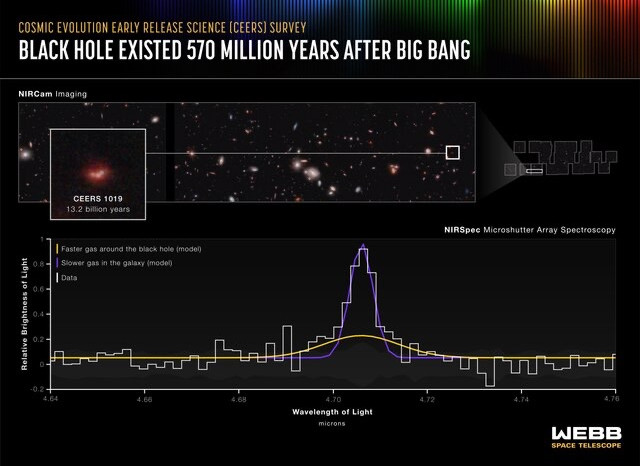James Webb Telescope Unveils the Earliest Black Hole in the Universe
August 13, 2025
by Jaymie Johhns

The James Webb Space Telescope (JWST) has once again pushed the boundaries of human knowledge, detecting the earliest known black hole in the universe within the distant galaxy CAPERS-LRD-z9, a mere 500 million years after the Big Bang. This groundbreaking discovery, detailed in a study published in the Astrophysical Journal Letters and reported by Live Science, offers an unparalleled look into the cosmos's infancy, dating back over 13 billion years. By peering as far back as practically possible, JWST is rewriting our understanding of black hole formation and the early universe, revealing a massive cosmic entity that challenges existing theories and highlights the telescope's extraordinary capabilities in exploring the dawn of time.
CAPERS-LRD-z9, classified as a "Little Red Dot" galaxy due to its compact size and reddish hue in JWST's infrared images, hosts a black hole with a mass 38 million times that of the sun. Located 13.3 billion light-years away, this black hole represents a relic from the universe's formative era, when galaxies and their central black holes were just beginning to take shape. Astronomers from the University of Texas at Austin, leading the CAPERS survey, identified the black hole through a distinctive pattern of light wavelengths captured by JWST's sensitive instruments, indicating gas spiraling into the gravitational monster. This observation not only confirms CAPERS-LRD-z9 as the site of the earliest verified black hole but also suggests that such massive objects formed and grew far quicker than previously thought, defying traditional models of cosmic evolution.
Little Red Dot galaxies like CAPERS-LRD-z9 have emerged as one of JWST's most intriguing surprises since its launch in December 2021. These compact, red-tinted galaxies, invisible to previous telescopes, appear to dominate the early universe, packed with stars and often harboring oversized black holes. In CAPERS-LRD-z9, the black hole accounts for about 5% of the galaxy's stellar mass, a ratio vastly higher than in modern galaxies like the Milky Way, where the central black hole is just 0.1% of the total mass. This anomaly implies that black holes in the early universe may have played a dominant role in galactic development, perhaps feeding voraciously on surrounding gas or forming through exotic processes like the collapse of massive gas clouds rather than from stellar remnants. As study co-author Steven Finkelstein noted in Live Science, this finding pushes the limits of observation, looking "as far back as you can practically go" to uncover the universe's hidden origins.
The discovery raises profound questions about black hole formation. Conventional theory suggests black holes grow over time through mergers and accretion, but the existence of such a massive one so soon after the Big Bang—when the universe was only 500 million years old—hints at accelerated growth mechanisms. Possibilities include primordial black holes born in the Big Bang's chaotic aftermath or rapid mergers in dense early galaxies. JWST's infrared prowess, allowing it to cut through cosmic dust and capture redshifted light from distant objects, has been key to this revelation. The telescope's Near-Infrared Spectrograph (NIRSpec) detected the telltale signature of an accretion disk, where gas heats up as it swirls into the black hole, emitting light at specific wavelengths. This precision confirms the black hole's presence, ruling out alternatives like intense star formation bursts that could mimic the signal.
The implications for cosmology are staggering. If black holes like the one in CAPERS-LRD-z9 were common in the early universe, they could have influenced galaxy formation more than previously imagined, perhaps seeding the growth of stars or expelling gas through powerful jets. This challenges the standard hierarchical model, where galaxies form first and black holes grow within them, suggesting instead a co-evolutionary process or even black holes driving galactic development. The CAPERS survey, part of JWST's broader mission to study the first billion years after the Big Bang, has already identified other Little Red Dot galaxies with similar characteristics, indicating that CAPERS-LRD-z9 is not an outlier but part of a larger pattern in the early cosmos.
JWST's success stems from its innovative design, including a massive 21-foot mirror and sunshield that enable it to observe in infrared from its orbit at Lagrange Point 2, a million miles from Earth. Since its first images in July 2022, JWST has consistently delivered breakthroughs, from exoplanet atmospheres to distant quasars. The CAPERS-LRD-z9 discovery, achieved through targeted observations of high-redshift galaxies, exemplifies the telescope's ability to answer fundamental questions about the universe's birth, such as how black holes and galaxies co-evolved in the cosmic dawn.
Critics of the study, as noted in Live Science, caution that confirming the black hole's nature required careful analysis to exclude other explanations, like unusually bright star clusters. The research team addressed this by examining the light spectrum's unique features, strengthening the finding's reliability. Future JWST observations will likely target more Little Red Dot galaxies, potentially uncovering additional early black holes and refining models of cosmic evolution. This work not only advances astrophysics but also inspires wonder about our place in the universe, reminding us that the cosmos's secrets are gradually yielding to human ingenuity.
The CAPERS-LRD-z9 black hole stands as a testament to JWST's revolutionary impact, offering a window into a time when the universe was young and chaotic. As astronomers continue to analyze the data, this discovery will undoubtedly spark new theories and debates, propelling our quest to understand the origins of everything. JWST, by looking as far back as practically possible, is not just observing the past—it's illuminating the path to future discoveries in the vast expanse of space.



